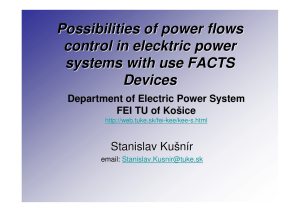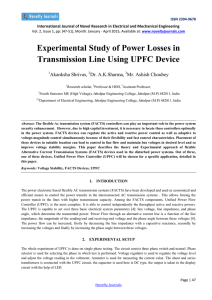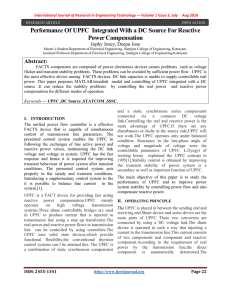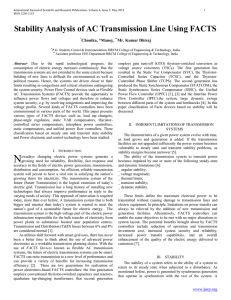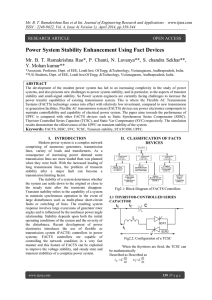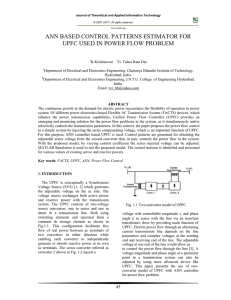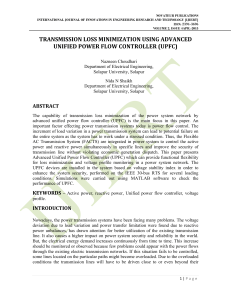Power Flow Control using UPFC Facts Controller
advertisement
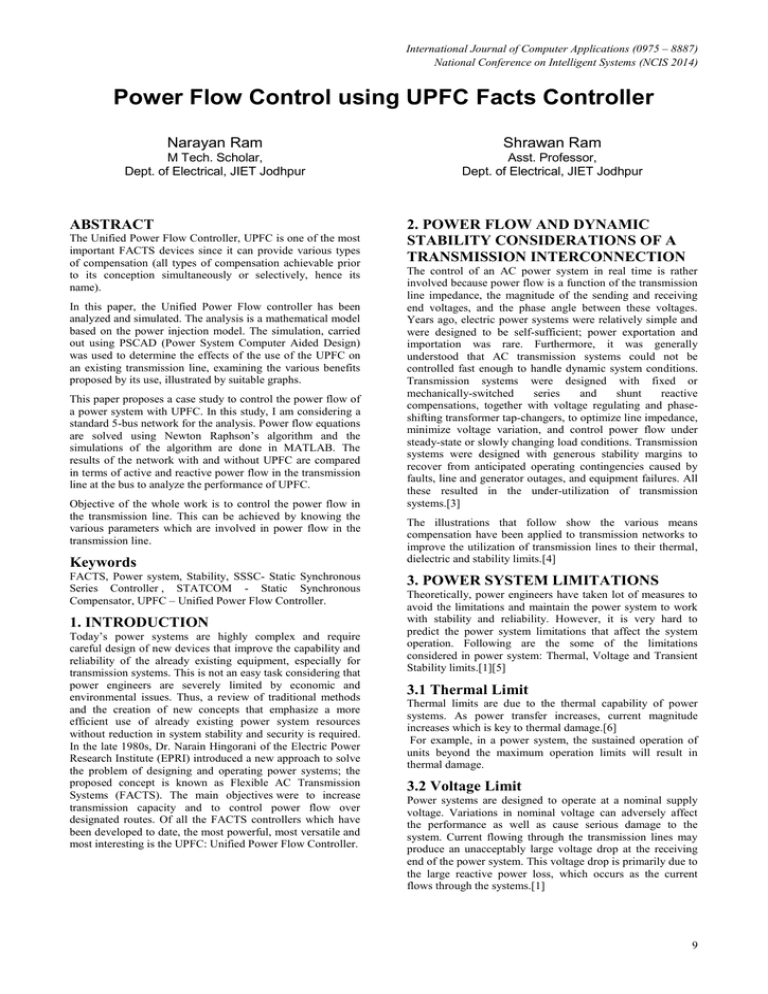
International Journal of Computer Applications (0975 – 8887) National Conference on Intelligent Systems (NCIS 2014) Power Flow Control using UPFC Facts Controller Narayan Ram Shrawan Ram M Tech. Scholar, Dept. of Electrical, JIET Jodhpur Asst. Professor, Dept. of Electrical, JIET Jodhpur ABSTRACT The Unified Power Flow Controller, UPFC is one of the most important FACTS devices since it can provide various types of compensation (all types of compensation achievable prior to its conception simultaneously or selectively, hence its name). In this paper, the Unified Power Flow controller has been analyzed and simulated. The analysis is a mathematical model based on the power injection model. The simulation, carried out using PSCAD (Power System Computer Aided Design) was used to determine the effects of the use of the UPFC on an existing transmission line, examining the various benefits proposed by its use, illustrated by suitable graphs. This paper proposes a case study to control the power flow of a power system with UPFC. In this study, I am considering a standard 5-bus network for the analysis. Power flow equations are solved using Newton Raphson’s algorithm and the simulations of the algorithm are done in MATLAB. The results of the network with and without UPFC are compared in terms of active and reactive power flow in the transmission line at the bus to analyze the performance of UPFC. Objective of the whole work is to control the power flow in the transmission line. This can be achieved by knowing the various parameters which are involved in power flow in the transmission line. Keywords FACTS, Power system, Stability, SSSC- Static Synchronous Series Controller , STATCOM - Static Synchronous Compensator, UPFC – Unified Power Flow Controller. 1. INTRODUCTION Today’s power systems are highly complex and require careful design of new devices that improve the capability and reliability of the already existing equipment, especially for transmission systems. This is not an easy task considering that power engineers are severely limited by economic and environmental issues. Thus, a review of traditional methods and the creation of new concepts that emphasize a more efficient use of already existing power system resources without reduction in system stability and security is required. In the late 1980s, Dr. Narain Hingorani of the Electric Power Research Institute (EPRI) introduced a new approach to solve the problem of designing and operating power systems; the proposed concept is known as Flexible AC Transmission Systems (FACTS). The main objectives were to increase transmission capacity and to control power flow over designated routes. Of all the FACTS controllers which have been developed to date, the most powerful, most versatile and most interesting is the UPFC: Unified Power Flow Controller. 2. POWER FLOW AND DYNAMIC STABILITY CONSIDERATIONS OF A TRANSMISSION INTERCONNECTION The control of an AC power system in real time is rather involved because power flow is a function of the transmission line impedance, the magnitude of the sending and receiving end voltages, and the phase angle between these voltages. Years ago, electric power systems were relatively simple and were designed to be self-sufficient; power exportation and importation was rare. Furthermore, it was generally understood that AC transmission systems could not be controlled fast enough to handle dynamic system conditions. Transmission systems were designed with fixed or mechanically-switched series and shunt reactive compensations, together with voltage regulating and phaseshifting transformer tap-changers, to optimize line impedance, minimize voltage variation, and control power flow under steady-state or slowly changing load conditions. Transmission systems were designed with generous stability margins to recover from anticipated operating contingencies caused by faults, line and generator outages, and equipment failures. All these resulted in the under-utilization of transmission systems.[3] The illustrations that follow show the various means compensation have been applied to transmission networks to improve the utilization of transmission lines to their thermal, dielectric and stability limits.[4] 3. POWER SYSTEM LIMITATIONS Theoretically, power engineers have taken lot of measures to avoid the limitations and maintain the power system to work with stability and reliability. However, it is very hard to predict the power system limitations that affect the system operation. Following are the some of the limitations considered in power system: Thermal, Voltage and Transient Stability limits.[1][5] 3.1 Thermal Limit Thermal limits are due to the thermal capability of power systems. As power transfer increases, current magnitude increases which is key to thermal damage.[6] For example, in a power system, the sustained operation of units beyond the maximum operation limits will result in thermal damage. 3.2 Voltage Limit Power systems are designed to operate at a nominal supply voltage. Variations in nominal voltage can adversely affect the performance as well as cause serious damage to the system. Current flowing through the transmission lines may produce an unacceptably large voltage drop at the receiving end of the power system. This voltage drop is primarily due to the large reactive power loss, which occurs as the current flows through the systems.[1] 9 International Journal of Computer Applications (0975 – 8887) National Conference on Intelligent Systems (NCIS 2014) 3.3 Transient Stability It is defined as the ability of power system to maintain synchronism when it is subjected to severe transient disturbance. In general, power systems with long transmission lines are most susceptible to transient instability. The best way to analyze the transient stability limit is to study the change of rotor angle of all synchronous machines connected to the system after the system subjected to large disturbance.[7] 4. TYPES OF FACTS CONTROLLERS In general FACTS controllers can be divided into the following four categories: 4.1 Series Controllers In principle all the series controllers inject voltage in series with the line. Series connected controller impacts the driving voltage and hence, the current and power flow directly. Static Synchronous Series Compensator (SSSC), Thyristor Controlled Series Compensator (TCSC) etc. are the examples of series controllers.[8] 4.2 Shunt Controllers All shunt controllers inject current into the system at the point of connection. The shunt controller is like a current source, which draws/injects current from/into the line. Static Synchronous Compensator (SSC), Static Synchronous Generator (SSG), Thyristor Controlled Reactor (TCR) etc are the examples of shunt controllers.[8] Fig 1: Unified Power Flow Controller It consists of two back-to-back self-commutated voltage source converters - one converter at the sending end is connected in shunt as shunt converter and the other converter connected in between sending and receiving end bus in series as series converter. One end of the both the converters are connected to a power system through an appropriate transformer and other end connected with a common DC capacitor link.[9] 6. CASE STUDY OF A NETWORK WITH UNIFIED POWER FLOW CONTROLLER 4.3 Combined Series-Shunt Controllers This could be a combination of separate shunt and series controllers, which are controlled in a coordinated manner. Combined shunt and series controllers inject current into the system with the shunt part of the controller and voltage in series in the line with the series part of the controller. Unified Power Flow Controller (UPFC) and Thyristor Controlled Phase Shifting Transformer (TCPST) are the examples of shunt series controllers.[4] 4.4 Combined Series-Series Controllers This could be a combination of separate series controllers, which are controlled in a coordinated manner, in a multi-line transmission system or it could be a unified controller, in which series controller provides independent series reactive compensation for each line but also transfer real power among the line via the power link.[4] There are various FACTS devices, but the one of interest in this paper is the Unified Power Flow Controller, UPFC which controls transmission line voltage, angle, and impedance and by this, it achieves simultaneous control of real and reactive power on a transmission line as well as keep bus voltages within acceptable limits thus solving the majority of the transmission problems, pushing an existing transmission line to its thermal, dielectric and stability limits. 5. UNIFIED POWER FLOW CONTROLLER Gyugyi in 1991 proposed the Unified Power Flow Controller. It is the most versatile and complex power electronic device and member of third generation FACTS Controller introduced to control the power flow and voltage in the power systems. It is designed by combining the features of second-generation FACTS controllers – Series Synchronous Compensator (SSSC) and Static Synchronous Compensator (STATCOM). It has the ability to control active and reactive power flow of a transmission line simultaneously in addition to controlling all the transmission parameters (voltage, impedance and phase angle) affecting the power flow in a transmission line. Fig 2: A Standard 5-Bus Network with UPFC I considered a standard 5- bus network with UPFC to study the power flow control of a power system. For the analysis as shown in Fig 2, bus 1 considered as slack bus, buses 2 and 3 as voltage control buses and buses 4, 5 as load buses. To include a unified power flow controller an additional bus 6 placed in between buses 3 and 4 in the network. It maintains the active and reactive powers leaving the UPFC towards the bus 4. The UPFC shunt converter is set to regulate bus 3 nodal voltage magnitude at 1 pu. Simulations: The case network shown in Fig 2 is solved by using MATLAB programming. MATLAB is a widely used tool in power systems for simple mathematical manipulations with matrices, for understanding and teaching basic mathematical and engineering concepts. MATLAB in power systems used for analyzing power system steady-state behavior and its capabilities for simulating transients in power system including control system behavior. In this paper, MATLAB programming with Newton Raphson algorithm used to find out the method to solve the control setting of the 5-bus network with UPFC. In large-scale power flow studies the Newton-Raphson method has proved out to be the most successful algorithm with its strong convergence characteristics. In order to apply Newton-Raphson method to the power flow problem the relevant equations expressed in the form of unknown nodal voltage magnitudes and phase angles.[10] The functions power flow data is used to read the network data and the UPFC data is used to read the UPFC data. Admittance matrix called to solve for the formation of Y Bus and the UPFC Newton Raphson function called to solve the nodal voltage magnitude and phase angle for the number of iterations.[10] PQ UPFC Power called to solve for the active and reactive power at sending and receiving end bus with 10 International Journal of Computer Applications (0975 – 8887) National Conference on Intelligent Systems (NCIS 2014) UPFC. In the main UPFC Newton-Raphson program, the function UPFC data added to read the UPFC data, UPFC PQ flow data called used to calculate the power flow and losses in the UPFC. By using the UPFC power equations from UPFC data with network equations from Power Flow data, UPFC calculated powers are obtained.[11] Power mismatches are calculated with UPFC and the Jacobian matrix is attained because of the inclusion of UPFC. If the convergence limit is not achieved, the Jacobian matrix modified by adding UPFC elements and power mismatches are calculated. This step continues until convergence is attained. Once the convergence is achieved the reactive and active power controlled in terms of Jacobean terms are calculated. Once the reactive and active power terms calculated the UPFC state variables are updated and check for the voltage source limits.[11] scheme is devised to control a particular system parameter affecting power flow. Thus, static var compensators are applied for reactive power and voltage control, controllable series compensators for line impedance adjustment, and tapchanging transformers for phase-shift. Each of these is a custom-designed system with different manufacturing and installation requirements. They have inherent limitations with regard to manufacturing and installation complexity, physical size and relatively high overall cost.[12] Practically, the unified power flow controller makes it possible to handle the power flow control and transmission line compensation problems uniformly, using solid-state voltage sources instead of switched capacitors and reactors or tap changing transformers. UPFC minimizes the installation labor requirements, and makes the capital cost primarily dependent on the cost of the solid-state components, which are decreasing trend with advancement of technology.[13] 8. RESULTS Table 1. Power Flow Control with and without UPFC Active Power (MW) Fig 3 Simplified Block Diagram of the Series Converter Control System Fig 4 Control Schemes Sending End Power (MW) Receiving End Power (MW) 37.3 36.68 Without UPFC 71.84 61.08 With UPFC Fig 5: Sending end and Receiving end Active Power without UPFC 7. ADDITIONAL FEATURES OF UPFC UPFC can be controlled by using following objectives simultaneously in the power systems: (i) Regulating power flow through a transmission line of power systems. (ii) Minimizing the power losses without generator rescheduling. (iii) Dynamic Security: In the past years, preventive control has been considered as the only strategy to control the dynamic security of the power systems, since the instability in the system occurs rapidly and no manual intervention is possible. Preventive control obtained by rescheduling of active power is generally of higher cost than the one obtained by economic dispatch. UPFC controllers can control the security of the network under the large disturbances associated to generation and load.[8] 7.1 Comparison of UPFC with other FACTS devices Conventional thyristor-controlled power flow controllers employ the traditional power system compensation in which mechanical switches are replaced by thyristor valves. Each Fig 6: Sending end and Receiving end Active Power with UPFC First result shows the active power through the line without UPFC. And second result shows the active power flow through line controlled by the UPFC, the transmission capability of the existing transmission line is highly improved with the presence of UPFC, but the difference between the sending-end real power and receiving end real power is high in the transmission line with UPFC due to the increase in transmission losses, which include losses in the both converters and coupling transformers.[5] 11 International Journal of Computer Applications (0975 – 8887) National Conference on Intelligent Systems (NCIS 2014) 9. CONCLUSION This paper deals with the case study of power flow control with the Unified Power Flow Controller (UPFC) that is used to maintain and improve power system operation and stability. This paper also presents the power flow operation of power systems and its limitations, different devices to control the power flow with the existing transmission lines, types of FACTS controllers used in the power system, basic characteristics and operation of UPFC, Newton Raphson flow chart and algorithm with UPFC and a case study to study the power flow control with UPFC. The Unified Power Flow Controller provides simultaneous or individual controls of basic system parameters like transmission voltage, impedance and phase angle there by controlling the transmitted power. In this paper, a 5-bus network is considered and power flow program with UPFC is simulated in MATLAB. Simulation results have shown that controller exhibits good damping characteristics for different operating conditions. This feature to control simultaneously all the transmission parameters cannot be accomplished with the mechanical and other FACTS devices. The results obtained in this paper can further improved by: To consider the effect of different input signals such as line current, difference in sending and receiving end bus voltages, phase angles, etc., on the damping controller performance. To include more than one UPFC for the advanced features in the power systems. 10. REFERENCES [3] Jinfu Chen, Xinghua Wang, Xianzhong Duan, Daguang Wang, Ronglin Zhang, “Application of FACTS Devices for the Interconnected Line Between Fujian Network and Huadong Network”, IEEE. [4] S. Tara Kalyani, G. Tulasiram Das, “Simulation of Real and Reactive Power Flow Control With UPFC connected to a Transmission Line”, Journal of Theoretical and Applied Information Technology, 2008. [5] S. Y. Ge, T S Chung, “ Optimal Active Power Flow Incorporating Power Flow Control Needs In Flexible AC Transmission Systems”, IEEE Transactions on Power Systems, Vol. 14, No.2, 2009. [6] K. R. Padiyar, A. M. Kulkarni, “Flexible AC transmission systems: A status review”, Sadhana, Vol.22, Part 6, pp. 781-796, December 1997. [7] John J. Paserba, “How FACTS Controllers Benefit AC Transmission Systems”, IEEE. [8] Nadarajah Muthulananthan, Arthit Sode-yome, Mr. Naresh Acharya, “Application of FACTS Controllers in Thailand Power Systems”, Asian Institute of Technology, Jan 2005. [9] Jody Verboomen, Dirk Van Hertem, Pieter H. Schavemaker, Wil L. Kling, Ronnie Belmans, “ Phase Shifting Transfomers: Princples and Application”, IEEE. [10] M. P. Bahrman, P.E., “HVDC Transmission Overview”, IEEE. [1] N.G Hingorani G. Gyugyi Lazlo “Understanding FACTS: Concepts & technology of flexible AC Transmission Systems” ISBN 0-7803-3455-8. [11] W. Breuer, D. Povh, D. Retxmann, E. Teltsch, “Trends for Future HVDC Applications”, 16th Conference of Electric Power Supply Industry, November 2006. [2] R.Billinton, L. Salvaderi, J.D. McCalley, H. Chao, Th. Seitz, R.N. Allan, J. Odom, C. Fallon, “Reliability Issues In Today’s Electric Power Utility Environment”, IEEE Transactions on Power Systems, Vol. 12, No. 4 November 1997. [12] Rajiv K. Varma, “Introduction to FACTS Controllers”, Member, IEEE. IJCATM : www.ijcaonline.org [13] M. Noroozian, C. W. Taylor, “Benefits of SVC and STATCOM for Electric Utility Application”. 12
